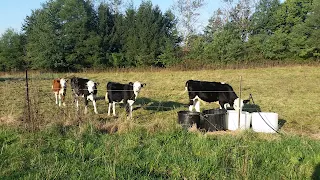 |
| I had a reader ask me about windbreaks. You can click on the image to embiggen. |
 |
| So I took a bunch of pictures. Most of them are from the east and looking west. Our prevailing wind is from the west-southwest. |
 |
| Windbreaks present a few challenges. One challenge involves keeping the bottom dense so the wind does not blow beneath the bulk of the branches. |
 |
| Another challenge is producing ancillary benefits. The windbreak soaks up sunlight and water. We might as well attempt to get some kind of crop from it. |
 |
| The windbreak has shorter species on the edges and taller, mast producing species in the middle to give it a hump-shape |
 |
| Chestnut trees can play either position |
 |
| Some species are there because I like how they look. The tall trees in the center of the frame are P. grandidentata X P. alba and are about 60 feet tall. |
 |
| Black Locust tends to pop up everywhere. |
 |
| I intend to prune the spruce trees up about 8'. I hope that the sun hitting the ground will recruit appropriate species. |
 |
| My electric fences are curvy. A fence that is convex stays tight when the animals push it and requires few corner posts. |
 |
| Mulberries, grape vines, crab apples, persimmons, chestnuts, sumac, blackberries and domestic apple seedlings thicken up the edges. |
 |
| Taller species in the center include Black Locust, Swamp White Oak, Sawtooth Oak, Northern Red Oak, English Oak and Black Walnut. |
 |
| LOTS of Illinois Everbearing Mulberry grafts. It has a very long period of fruiting. |



I avoid wildlife corridors because they are used by coyotes, and up here wolves, and with the way things are going two legged predator's could become an issue.---ken
ReplyDeleteTalking out my backside, but if you can funnel them can you snare them?
DeleteIt's not really that easy. Rabbits, beaver and muskrats are easy to snare but coyotes not so much. And if you snare them you have to get rid of them and that could be a problem with a collared wolf particularly when you cannot know if the collar is functioning. That's only what I hear of course.--ken
DeleteJust came back from Colorado. You have more trees in those pictures than I saw in over 140 miles of travel...
ReplyDeleteWe called them shelter belts. They planted them all over SW Oklahoma to help recover after the dust bowl. My folks were stubborn and didn't flee to Kalifornia.... They stuck it out.
ReplyDeleteOur windbreaks here in Texas are known elsewhere as barbed wire.
ReplyDeleteLooks like a nice piece of ground!
ReplyDelete